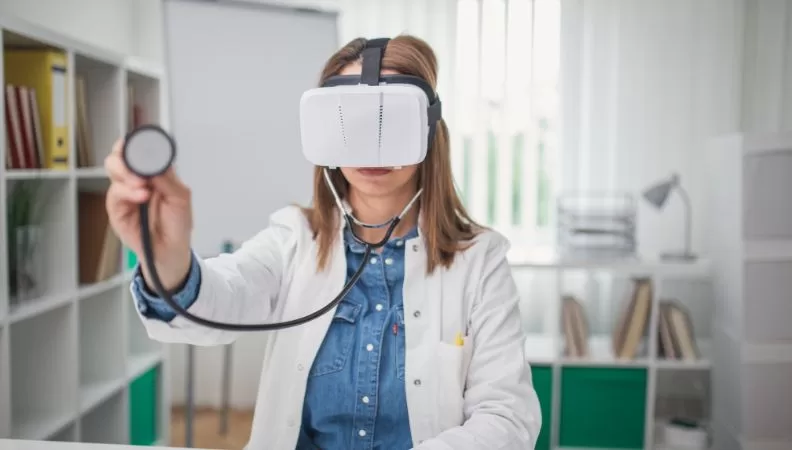Revolutionizing Healthcare: The Impact of Virtual Reality in Medicine
The advent of Virtual Reality (VR) has brought transformative changes across numerous industries, and healthcare is no exception. Initially thought of as a tool for entertainment, VR has evolved into a highly effective technology in medicine. From managing chronic pain to revolutionizing medical training, VR is reshaping healthcare in ways once thought impossible. As healthcare continues to embrace new technologies, VR is becoming a powerful ally in improving both patient care and medical education.
What is Virtual Reality? Introduction to Virtual Reality
Virtual reality is a technology that creates an artificial environment to immerse the user in a fully interactive computer-generated world. Using specialized equipment such as head-mounted displays, gloves, and motion sensors, users can be immersed in a 3D, lifelike environment that feels real to the senses. In healthcare, virtual reality closes the gap between physical reality and digital experiences to allow patients and medical professionals to engage with virtual environments for therapeutic or educational purposes.
Key Technologies Powering Virtual Reality in Healthcare
The core of VR in healthcare is its ability to provide highly immersive experiences. This is made possible by advancements in high-resolution displays, motion tracking systems, and 3D audio technologies. The combination of these technologies allows for seamless interaction, making VR an invaluable tool for pain management, surgical simulations, and therapeutic interventions.
How Virtual Reality is Transforming and Revolutionizing Healthcare
Bridging the Gap Between the Physical and Digital Worlds:-
VR creates experiences in digital worlds that are immediately tangible to the user. To a patient, that is such an opportunity to step into a virtual world and experience things that may be impossible or very difficult in a real setting, such as walking again after a stroke and seeing pain relief throughout treatment.
Improving Patient Experiences and Boosting Clinical Efficiency
VR reduces anxiety, increases patient engagement, and makes treatments less intimidating. Whether it is a VR game for a child undergoing chemotherapy or a soothing virtual landscape for a patient undergoing a painful procedure, VR enhances the healthcare experience by making it more engaging and less stressful.
Overcoming the Limitations of Traditional Treatment Methods
Traditional treatments often come with limitations, including side effects, long recovery times, or difficulty in engaging patients. VR offers a new avenue for treating conditions in ways that traditional methods cannot, improving both patient outcomes and the quality of care.
Benefits of Virtual Reality in Healthcare: Pain Management & Stress Reduction
Virtual reality has been shown to be very effective in managing pain, especially during medical treatments. The method of distracting the patient with some interesting virtual experiences reduces the perceived pain and enables them to accept treatments like wound care, physical therapy, and dental procedures.
Enhancing Patient Engagement and Treatment Compliance
The patients find VR-based therapies more interactive and immersive. So, they stick to rehabilitation programs and medical treatment more diligently.
Virtual reality changes the face of medical training: Virtual reality changes the way of training medical personnel. It creates an immersive setting where doctors may practice complex procedures without putting any patient at risk. This leaves the medical staff better prepared while reducing the training costs.
Achieving Better Outcomes in Mental Health Treatment
VR-based mental health treatment can be used for the treatment of psychiatric illness conditions such as anxiety, PTSD, and phobias. Therapists can create environments that allow patients to be exposed to their triggers in a safe and manageable way, hence improving the outcomes of therapy.
Enhancing Surgical Accuracy and Efficiency for Better Outcomes
VR allows surgeons to practice complex procedures before performing them on real patients. By visualizing surgeries in a 3D space, they can perfect their techniques, leading to improved precision and reduced errors.
Types of Virtual Reality Applications in Healthcare
Pain Management and Distraction Therapy
VR pain management involves putting patients in virtual worlds that distract them from the pain they are experiencing. This type of therapy has been particularly successful in reducing the need for opioid painkillers and minimizing discomfort during medical treatments.
Medical Training and Simulation Using Virtual Reality
Medical simulations are one of the most important applications of VR in healthcare. Doctors can practice surgeries, procedures, and diagnostic assessments in a virtual environment, so they can perfect their skills before doing real procedures.
Virtual Reality in Physical Rehabilitation and Therapy
VR rehabilitation employs immersive exercises and movements to help patients recover from injuries or surgeries. It gives them real-time feedback and a sense of accomplishment, motivating patients to push through rehabilitation exercises.
Virtual Reality for Psychological Treatment and Stress Relief
VR has effectively been used in the treatment of psychological issues such as stress, anxiety, and even phobias. Therapists can expose patients to controlled virtual scenarios where patients’ fears and triggers can be lessened and even overcome gradually while these are still in a safe environment.
Virtual Reality in Surgical Planning and Precision Surgery
Surgeons use VR to plan and visualize surgeries before doing them on actual patients. This allows them to think through the best course of action, anticipate potential complications, and even practice techniques in a 3D environment.
Exploring the Role of VR in Pain Management
How does VR Provide Pain Relief Through Distraction
VR can be used as a distraction therapy by exposing the patients to an interesting virtual environment. In doing so, they are distracted from their pain in the body and hence experience less discomfort with a reduced level of pain.
Why VR Works for Acute and Chronic Pain
Studies have demonstrated that VR is effective for both acute and chronic pain. In the case of acute pain, it helps during short-term procedures, while in the case of chronic pain, VR offers longer-term relief by reducing the overall pain experience and encouraging more positive emotional responses.
Benefits of VR in Reducing Opioid Usage
By providing an opioid-free pain management option, VR may become a means for reducing medication reliance on opioids, thus reducing some of the risks associated with opioid addiction and overdose.
Why VR is Crucial for Advancing Medical Training
Simulation of Complex Procedures and Situations
Through VR, it is possible to simulate very complex medical procedures, be these surgeries or emergency responses, within a risk-free environment. Simulating skills and readiness in such ways definitely do not threaten patients’ safety.
Why VR is Safer Than Traditional Training Methods
In traditional training methods, medical students practice on cadavers or real patients, which carries inherent risks. VR allows for limitless practice in a safe, controlled setting, enabling students to gain proficiency without putting real patients at risk.
Benefits of Immersive Learning for Medical Professionals
It gives the students hands-on experience, so retention improves. Medical practitioners can practice the procedures repeatedly; their skills will be enhanced as well and the confidence they acquire is something no textbook or lecture can do for them.
Different Types of VR-Based Medical Training
Surgery Simulation and Practice
Surgical procedures like neurosurgery or orthopedics can be practiced by surgeons using virtual reality. Realistic simulations of human anatomy make this possible and help them fine-tune the techniques without risking a live patient.
Diagnostic Skills Training
Doctors and healthcare professionals can employ VR to improve their skills at diagnosing various conditions using case studies of virtual patients, improving decision-making, and diagnostic efficiency.
VR for Emergency Response and Trauma Training
Simulation through VR gives emergency responders and trauma surgeons training on how to deal with real-life high-pressure situations such as car accidents and natural disasters in a simulated manner.
VR in Mental Health Treatment
What’s the Role of VR in Mental Health Disorders?
Offering mental health treatment innovations, such as PTSD, anxiety, and depression, VR technology allows the development of a treatment plan with no fear and associated overwhelming emotions present in the face of real-world exposure.
VR Can Help Treatment of PTSD, Anxiety, Phobias
VR enhances exposure therapy, a widely used treatment for PTSD and phobias. The technique of using virtual simulations of their triggers to immerse patients helps them gradually desensitize to the stimuli in a safe and manageable way.
Why VR-Based Therapy is Gaining Popularity
The immersive nature of VR makes it a more engaging and effective treatment option compared to traditional therapies. Patients can experience real-world scenarios in a virtual setting, leading to more rapid progress and positive outcomes.
Benefits of Exposure Therapy in a Controlled Environment
Exposure therapy using VR allows patients to face their fears in a safe, gradual manner. This method is less intimidating than real-world exposure and can be customized to each patient’s comfort level.
The Role of VR in Enhancing Physical Rehabilitation
What is VR Rehabilitation Therapy?
VR rehabilitation therapy uses immersive virtual environments to help patients recover from injuries, surgeries, or physical disabilities. Such environments encourage patients to perform exercises and activities that help in the recovery of the body.
Why VR is Highly Effective in Physical Therapy
It is very effective in physical rehabilitation since it offers instant feedback to motivate patients to continue their exercises. It makes the process enjoyable and helps patients overcome the mental barriers associated with traditional therapy.
Benefits of Immersive VR Experiences for Recovering Patients
It encourages patients to be active and involved in their rehabilitation process since it offers real-time feedback and immersive environments. Better results and shorter recovery times are the outcome of this.
Different Types of VR Used in Physical Rehabilitation
Virtual Exercise Programs for Strengthening and Mobility
It will help patients through guided virtual exercise programs improve strength, mobility, and coordination while exercising.
Using VR for Post-Stroke Recovery and Rehabilitation
Patients who have suffered a stroke, and get back their ability to move along with coordination and balance through different virtual exercises representing real-life situations.
VR Rehabilitation Without Painfulness
The method of VR takes the patients far away from the uncomfortable feeling they might experience at the time of rehabilitation exercises using virtual environments.
Virtual Reality Surgery and Accuracy What is the Potential Role of Virtual Reality in the Surgical Process?
VR enables surgeons to visualize and practice complex surgeries in a 3D virtual environment before performing them on real patients. This leads to improved planning and better surgical outcomes.
How VR Can Enhance Surgical Accuracy in Healthcare
By offering detailed, realistic models of patient anatomy, VR enhances precision. Furthermore, it helps surgeons plan procedures effectively. Moreover, it minimizes risks by providing a clearer view of complex structures. As a result, VR reduces errors and improves surgical outcomes.
Benefits of VR for Pre-Surgical Visualization in Healthcare
VR allows surgeons to explore surgical approaches, predict complications, and plan strategies before surgery.
Restrictions and Limitations of VR in Healthcare
High Investment Costs and Technological Obstacles
The benefits of the technology notwithstanding, developing and sustaining it may be costly, especially in resource-poor settings.
Not all patients are comfortable with VR-based treatments, and some individuals may take time to adapt to virtual environments.
Data Security and Privacy Issues in Healthcare
Just like any other digital technology, the security of patient data is of utmost importance, and VR applications must be subject to stringent privacy regulations that will ensure the confidentiality of patient information.
Limited Availability in Resource-Constrained Settings
In many regions, the cost and complexity of VR technology limit its widespread availability, especially in developing countries or rural areas.
Exploring the Future of Virtual Reality in Healthcare
Emerging VR Technologies and Trends in Medicine
As technology advances, VR in healthcare evolves with innovations promising greater capabilities.
Why Virtual Reality Will Continue to Transform Healthcare
VR will remain transformative in healthcare, improving patient outcomes, medical training, and treatment methods.
Virtual Reality in Healthcare: The Future of AI and VR Integration in Medicine
AI and VR combined will offer advanced simulations, personalized treatments, and predictive analytics, elevating healthcare to new heights. Virtual reality has become a highly invaluable tool in the health sector. Everything from pain management to medical training has been revolutionized through it. Although many challenges still lie ahead, the benefits of patient care, medical education, and rehabilitation through VR cannot be ignored. Furthermore, VR offers significant improvements in treatment outcomes. Additionally, it enhances learning experiences for medical professionals. Moreover, its applications in rehabilitation are showing promising results. Ultimately, VR is revolutionizing healthcare, despite the hurdles that remain. As technology advances, VR’s role in enhancing healthcare and improving patient outcomes will continue to grow globally.
For more information about this ( Virtual Reality in Healthcare) visit our website or



